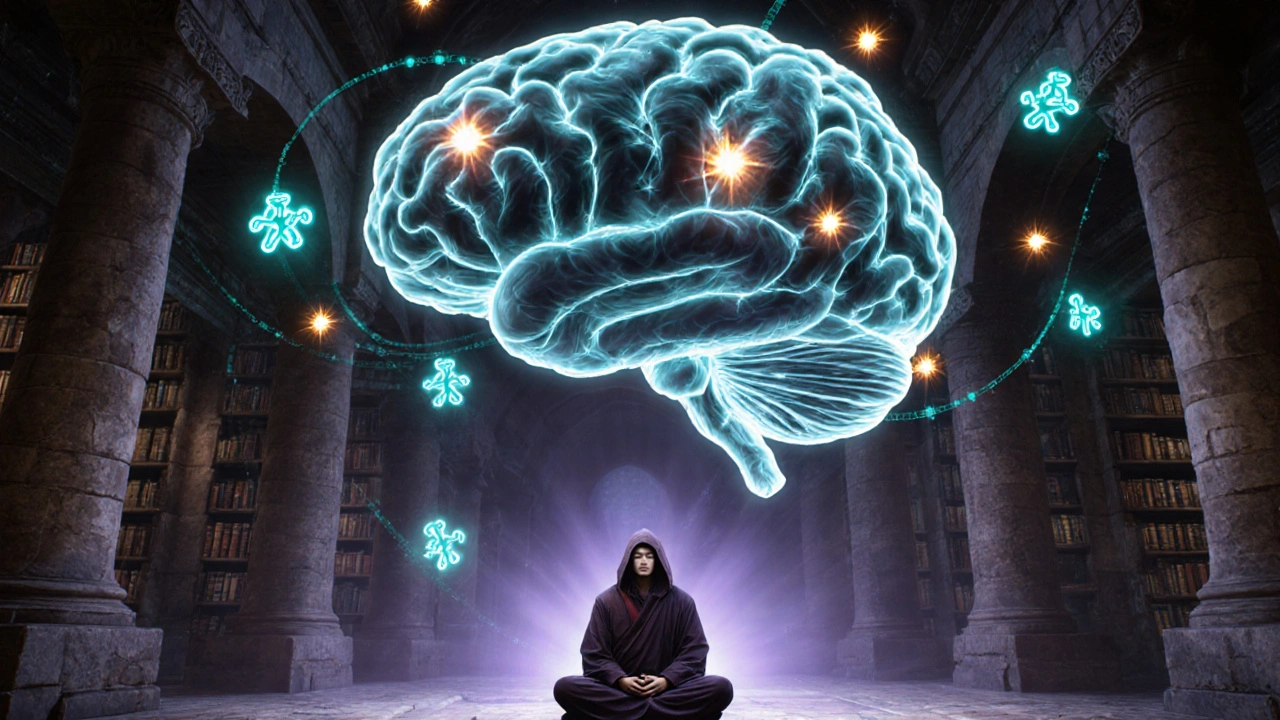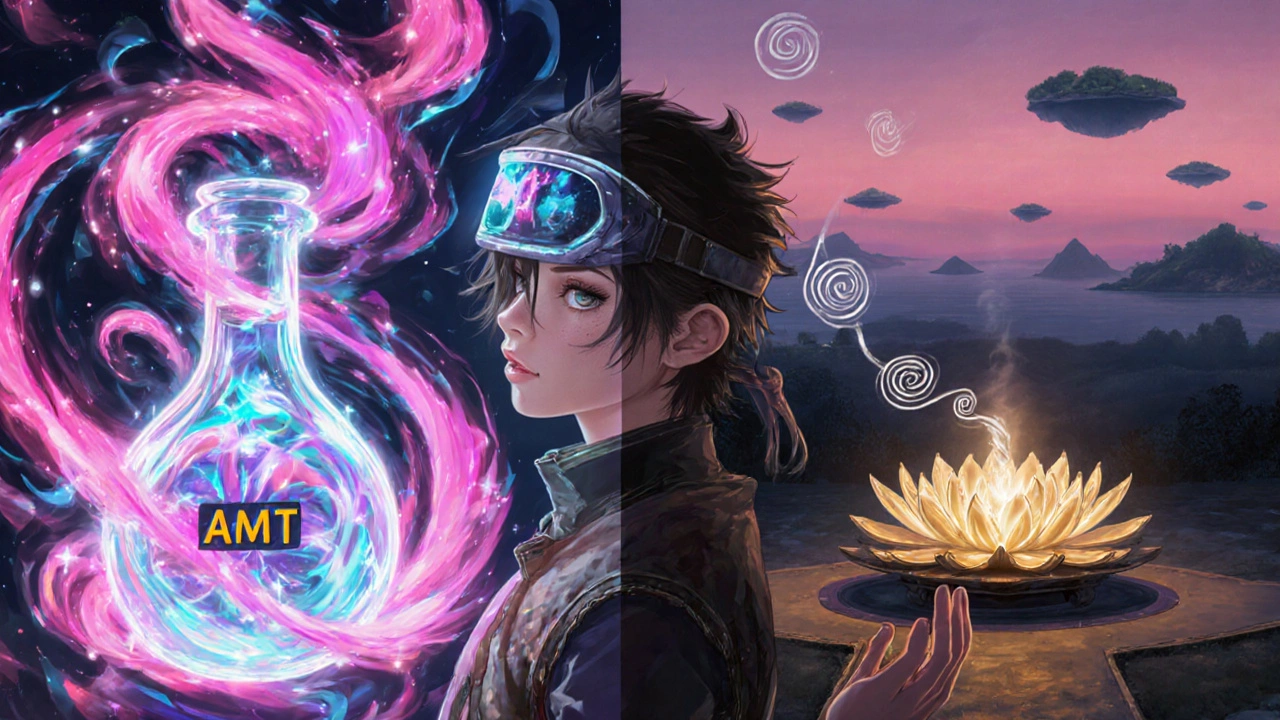Ever wonder why a synthetic psychedelic and a simple breath practice can both feel like stepping into another reality? The answer lies in how the brain builds and dissolves patterns of thought. Below we break down the chemistry of AMT drug, the mental mechanics of meditation, and what happens when the two worlds intersect.
Key Takeaways
- AMT (alpha‑methyltryptamine) stimulates serotonin receptors, producing vivid visual and emotional shifts that can last 8‑12hours.
- Meditation quiets the default mode network, leading to a calmer sense of self and heightened awareness.
- Both practices alter brainwave patterns, but the intensity and duration differ sharply.
- Combining AMT with meditation can amplify introspection but also raises safety concerns.
- Legal status varies globally; understanding risks is essential before experimenting.
What is AMT?
AMT is a synthetic tryptamine first synthesized in the 1960s. Chemically known as alpha‑methyltryptamine, it belongs to the same family as serotonin and psilocybin. When ingested, AMT binds primarily to the 5‑HT2A receptor a subtype of serotonin receptor linked to visual hallucinations and mood elevation, triggering a cascade of neurochemical events.
Typical oral doses range from 20‑50mg, producing effects that can last up to 12hours. Users report vivid colors, time distortion, and a sense of mental expansion. Because AMT is more resistant to metabolic breakdown than other psychedelics, its onset is slower (30‑90minutes) but its plateau is prolonged.
The Science Behind AMT’s Effects
Beyond serotonin, AMT also releases dopamine, which adds a stimulating quality often described as “a mix of LSD and amphetamine.” This dual action means the brain’s reward pathways light up, increasing heart rate and alertness while the visual cortex generates psychedelic imagery.
Neuroimaging studies on similar tryptamines show decreased activity in the default mode network (DMN) a network of brain regions active during mind‑wandering and self‑referential thinking. The DMN’s quieting is thought to underlie the feeling of ego dissolution that many users describe.
What is Meditation?
Meditation is a mental practice that trains attention and awareness. Techniques range from focused breathing to open‑monitoring mindfulness. Regular sessions reshape brain structure, increasing gray matter in regions linked to emotional regulation.
From a neurochemical standpoint, meditation boosts levels of gamma‑aminobutyric acid (GABA) the brain’s primary inhibitory neurotransmitter, promoting calm and reduces cortisol, the stress hormone. Like psychedelics, meditation also dampens the DMN, but the effect is subtler and builds over weeks of practice.

Altered States: A Shared Destination
Both AMT and meditation can usher the mind into what scientists call “altered states of consciousness.” The term covers any mental condition that differs markedly from ordinary waking awareness. Common markers include:
- Changes in perceived time.
- Heightened sensory vividness.
- Reductions in self‑referential thinking.
While the mechanisms overlap-mainly DMN suppression-the routes to get there differ. AMT hijacks serotonin pathways directly, producing an abrupt shift. Meditation trains the brain gradually, leading to a smoother transition.
Comparing AMT and Meditation
| Aspect | AMT | Meditation |
|---|---|---|
| Primary neurotransmitter impact | 5‑HT2A agonist, dopamine release | Increases GABA, reduces cortisol |
| Onset time | 30‑90minutes | Immediate (mindful breathing) to weeks (structural changes) |
| Duration of altered state | 6‑12hours | Minutes per session, cumulative over time |
| Intensity of visual phenomena | Strong, colored hallucinations | Rare, mainly internal imagery |
| Risk profile | Cardiovascular strain, psychosis trigger | Very low; occasional discomfort for beginners |
| Legal status (2025) | Controlled substance in most countries | Legal worldwide |
What Happens When You Combine AMT with Meditation?
Some experienced psychonauts report that meditative intent before a psychedelic trip can steer the journey toward insight rather than chaos. The rationale is simple: a calm mind may navigate the intense visual surge more smoothly.
Neuroscience backs this up lightly. A study on psilocybin showed that participants who practiced a brief mindfulness exercise before dosing had lower anxiety scores during the peak experience. By analogy, a pre‑meditation session before taking AMT could reduce the likelihood of panic.
However, the combination is not without danger. AMT’s stimulant component can raise heart rate, while deep breathing techniques can sometimes lead to hyperventilation if done too intensively. The safest approach is to start with a low dose of AMT (15mg), sit in a quiet space, and use a simple breath focus for 5‑10minutes.

Safety, Legal, and Ethical Considerations
Because AMT is classified as a ScheduleI substance in the US, Canada, the UK, and most of Europe, possession carries legal penalties. In certain countries like the Netherlands, it may be sold under research‑only licenses. Always verify local regulations before acquiring any substance.
From a health perspective, people with a history of psychosis, bipolar disorder, or cardiovascular disease should avoid AMT altogether. Even healthy users can experience lingering anxiety, sleep disruption, or flashbacks weeks after a high dose.
Meditation, by contrast, is widely endorsed by medical bodies for stress reduction and mood regulation. Yet beginners should still start with short sessions to prevent frustration, especially if they are new to quieting the mind.
Practical Guidelines for Curious Explorers
If you’re drawn to the idea of exploring consciousness, consider a step‑wise plan:
- Build a meditation habit. Aim for 10minutes daily for at least one month. Notice how your baseline stress levels shift.
- Research AMT thoroughly. Read peer‑reviewed articles on its pharmacology and risk profile.
- Set a safe environment. Choose a quiet room, have a sober sitter, and eliminate distractions.
- Start low, go slow. Begin with 10‑15mg of AMT, if legal, and watch the effects for at least an hour before deciding to take more.
- Integrate the experience. After the session, journal what you felt, then return to meditation to process insights.
Remember, the goal isn’t to chase a “high” but to gain perspective. If at any point the experience feels overwhelming, practice grounding techniques-feel your feet on the floor, sip water, or call a trusted friend.
Future Directions in Research
Scientists are now examining how psychedelics like AMT can be paired with structured mindfulness programs in clinical trials for depression and PTSD. Early pilots suggest that the combination may accelerate neuroplastic changes-making the brain more adaptable.
Key research questions include:
- Does pre‑meditation reduce the incidence of anxiety during a psychedelic session?
- Can the neural pathways activated by AMT be harnessed for long‑term therapeutic benefit?
- What dosage‑meditation protocols maximize safety while preserving insightful content?
Stay tuned to journals like Neuropsychopharmacology and The Journal of Consciousness Studies for upcoming findings.
Frequently Asked Questions
Is AMT safe to use with meditation?
Safety depends on dose, personal health, and setting. A low dose combined with a brief mindfulness practice can lower anxiety, but the stimulant aspect of AMT may still cause heart‑rate spikes. Anyone with cardiovascular or psychiatric history should avoid it.
How long does an AMT experience last compared to a meditation session?
A typical AMT trip endures 6‑12hours, while a meditation session ranges from a few minutes to an hour. Even seasoned meditators feel the after‑effects of AMT for several hours beyond the peak.
Can meditation replace psychedelics for personal growth?
Meditation provides steady, low‑risk development of self‑awareness and is legally accessible. Psychedelics can accelerate breakthroughs but carry higher risks. Many people use both sequentially-meditation for daily grounding, psychedelics for deeper therapeutic work.
What legal repercussions could I face for possessing AMT?
In most countries, AMT is a ScheduleI or equivalent controlled substance. Possession can lead to fines, criminal charges, or imprisonment. Always check your jurisdiction’s drug schedules before considering acquisition.
Are there any documented long‑term effects of combining AMT with meditation?
Long‑term studies are limited. Anecdotal reports suggest that integrating meditation after psychedelic sessions helps retain insights and reduces lingering anxiety. However, repeated high‑dose AMT use may lead to tolerance and potential neurotoxicity, so moderation is vital.

 Pharmacology
Pharmacology
Jacob Miller
August 21, 2025 AT 07:53Calling AMT a 'simple breath practice' sidesteps the serious cardiovascular dangers.
Anshul Gandhi
August 21, 2025 AT 21:13The government’s classification of AMT as a Schedule I substance isn’t just about public health, it’s about control.
The fact that meditation is promoted as “harmless” while the same brain pathways are weaponized shows a double standard.
If you look at the declassified CIA MK‑Ultra files, you’ll see experiments with tryptamines combined with sensory deprivation, which is essentially a forced meditation.
The industry that profits from mindfulness apps also sponsors research that downplays the need for regulated psychedelics.
This creates a feedback loop where the public thinks you can get the same insight for free by breathing, while the state monopolizes the chemically enhanced version.
Moreover, the “legal” status of AMT varies because some jurisdictions have lobbyists buying silence.
When you read the fine print on those “research‑only” licenses in the Netherlands, you’ll notice the same corporate names showing up in both pharma and tech.
The risk isn’t just physiological; it’s sociopolitical.
By limiting access to powerful chemicals, governments keep the population dependent on shallow wellness trends.
That’s why you’ll rarely see mainstream news reporting on the therapeutic potential of AMT, yet you’ll see endless articles on how to “quiet your mind.”
The neuroscience community is underfunded for real psychedelic trials, but flooded with grants for mindfulness studies.
So when a post like this glorifies the combination without mentioning the hidden power structures, it’s complicit.
The safest route is to stay skeptical of any claim that a drug can be “legally” safe without asking who benefits.
Remember, every time you swallow a schedule‑controlled substance, you’re also swallowing a piece of the state’s agenda.
Keep your mind open, but also keep your eyes on who’s pulling the strings behind the research.
Emily Wang
August 22, 2025 AT 11:06If you're looking to dip your toe into the psychedelic‑meditation combo, start with a solid meditation habit first.
A daily 10‑minute breath focus builds the mental safety net you’ll need when the AMT wave rolls in.
Keep the dose low-10‑15 mg is enough to feel the shift without overwhelming the heart.
Have a sober sitter, dim lights, and a playlist that’s soothing rather than stimulating.
Remember that the dopamine kick from AMT can mask anxiety, so check in with your body every 30 minutes.
Integrating the experience with journaling afterward cements the insights.
Emma French
August 23, 2025 AT 01:00Meditation offers a low‑risk path to self‑inquiry, and it’s great to see it framed alongside psychedelics responsibly.
Debra Cine
August 23, 2025 AT 03:46I love how you highlighted the need for a calm setting before dosing 😊.
Pairing a simple breath count with a low AMT dose can really smooth the ride 🌿.
Just remember to stay hydrated and keep the lights soft!
Rajinder Singh
August 23, 2025 AT 07:56Behold, the dance of neurotransmitters upon the stage of consciousness!
When serotonin and dopamine intertwine under AMT’s command, the mind becomes a tempest of colour and thought.
Introducing meditation at this juncture is akin to a skilled conductor soothing a raging orchestra.
Yet, the stakes are high; the heart may protest, and the psyche can be unmoored.
Therefore, approach this alchemical experiment with reverence and rigorous preparation.
Taylor Van Wie
August 23, 2025 AT 12:06This whole hype about blending foreign‑made psychedelics with Eastern breathwork is a distraction from real American resilience.
Our own research labs should focus on homegrown solutions, not import illicit substances.
Keep the nation’s health in our hands, not in the hands of overseas chemists!
carlee Lee
August 23, 2025 AT 16:16I agree: start small, stay safe, and let meditation ground the experience.
chuck thomas
August 23, 2025 AT 20:26Philosophically, both AMT and meditation act as mirrors that reflect the underlying architecture of consciousness.
One does so by chemically amplifying neural noise, the other by quietly attenuating the default mode chatter.
When they intersect, the mirror shatters and reforms, offering a glimpse of the self beyond narrative.
This can be a powerful catalyst for existential insight, provided the practitioner remains vigilant.
The key is intentionality: set a clear purpose before the journey begins.
Afterward, integrate the revelations through dialogue or writing, lest they dissipate like vapor.
In the long run, such practices may reshape one’s ontological assumptions.
Ultimately, the pursuit of altered states should serve growth, not escapism.